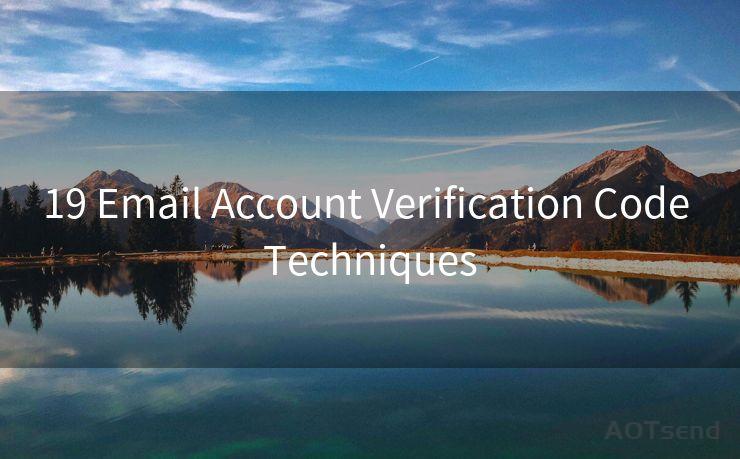19 Email Account Verification Code Techniques




In the digital age, email has become an indispensable tool for communication. However, with the rise of cybercrime, it's crucial to ensure that your email account is secure. One effective way to do this is through email account verification codes. In this article, we'll explore 19 techniques for implementing and managing email verification codes to enhance your account security.
1. Two-Factor Authentication (2FA)
Two-factor authentication adds another layer of security to your email account. When enabled, you'll receive a unique verification code via SMS, authenticator app, or hardware token, which must be entered along with your password to access your account.
2. Strong and Unique Passwords
Creating a strong and unique password for your email account is essential. Avoid using common words, phrases, or personal information that can be easily guessed. Use a combination of uppercase letters, lowercase letters, numbers, and special characters to create a robust password.
3. Regular Password Updates
Changing your password regularly reduces the risk of unauthorized access. Set a reminder to update your password every few months to ensure maximum security.

4. Email Encryption
Consider using email encryption services that provide end-to-end encryption for your emails. This ensures that even if someone intercepts your emails, they won't be able to read the content without the decryption key.
5. Secure Connection (SSL/TLS)
Always access your email account over a secure connection (HTTPS) using SSL/TLS encryption. This prevents eavesdropping and tampering with your data while it's in transit.
6. Avoid Public Wi-Fi
Public Wi-Fi networks are often unsecured and prone to attacks. Avoid accessing your email account on these networks, or use a VPN for added security.
7. Be Wary of Phishing Scams
Phishing scams are designed to steal your personal information, including email account credentials. Never click on suspicious links or provide sensitive information without verifying the source.
8. Use a Trusted Email Provider
Choose an email provider with a reputation for security and privacy. Providers with strong security measures and transparent privacy policies are more likely to protect your data.
9. Backup Your Data
Regularly backup your email data to prevent loss in case of an account breach or technical issue.
10. Monitor Account Activity
Regularly check your email account's activity log to identify any suspicious activity. This helps you detect and respond to potential security threats promptly.
11. Don't Forward Emails to External Accounts
Avoid forwarding your emails to external accounts, as this can expose sensitive information and increase the risk of unauthorized access.
12. Use Anti-Spam and Anti-Virus Software
Install anti-spam and anti-virus software to protect your device and email account from malicious attachments and links.
13. Be Cautious With Attachments
Never open attachments from unknown senders, as they may contain malware or viruses.
🔔🔔🔔
【AOTsend Email API】:AOTsend is a Managed Email Service for sending transactional emails. Support Email Types: reminders, authentication, confirmations, notifications, verification codes, invoices, password resets, account activations, billing statements, two-factor authentication (2FA), and one-time passwords (OTP) emails, etc. $0.28 per 1000 Emails. 99% Delivery, 98% Inbox Rate.
You might be interested in:
Why did we start the AOTsend project, Brand Story?
What is a Managed Email API, How it Works?
Best 25+ Email Marketing Platforms (Authority,Keywords&Traffic Comparison)
Best 24+ Email Marketing Service (Price, Pros&Cons Comparison)
Email APIs vs SMTP: How they Works, Any Difference?
14. Review Email Settings
Periodically review your email account settings to ensure that all security features are enabled and up to date.
15. Use Alias Email Addresses
Consider using alias email addresses for online services to protect your primary email address from spam and phishing attacks.
16. Log Out After Use
Always log out of your email account when you're not using it, especially on shared or public computers.
17. Avoid Storing Sensitive Information in Emails
Refrain from storing sensitive personal or financial information in your emails to reduce the risk of data leakage.
18. Educate Yourself on Email Security Best Practices
Stay informed about the latest email security threats and best practices to protect yourself from potential attacks.
19. Utilize Email Provider's Security Features
Take advantage of the security features offered by your email provider, such as advanced filters, spam protection, and account activity monitoring.
By implementing these 19 email account verification code techniques, you can significantly enhance the security of your email communication. Remember, email security is a shared responsibility between you and your email provider. Stay vigilant, and don't hesitate to reach out to your provider for assistance if you encounter any security issues.




Scan the QR code to access on your mobile device.
Copyright notice: This article is published by AotSend. Reproduction requires attribution.
Article Link:https://www.mailwot.com/p3162.html



